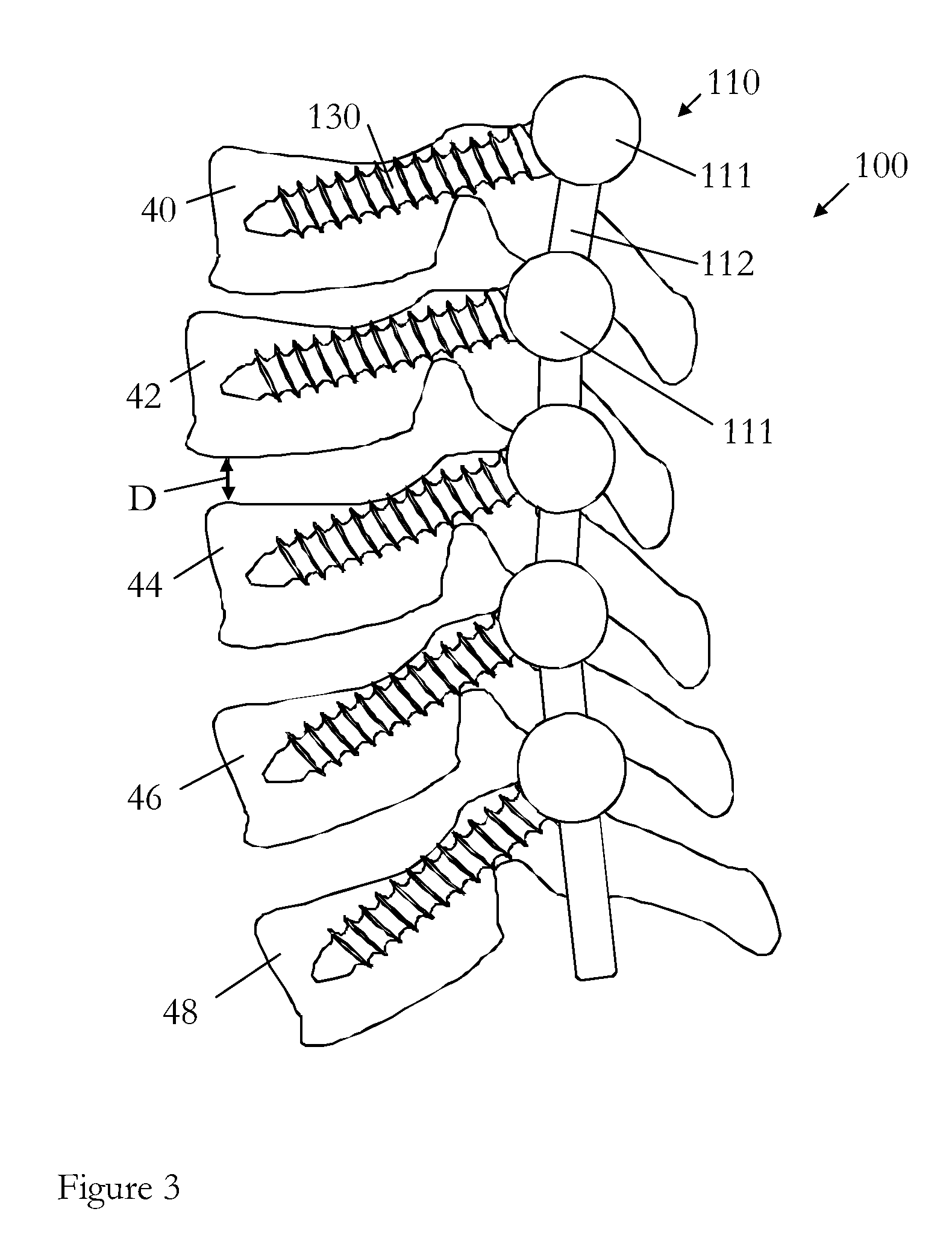Surgical device for correction of spinal deformities
a spinal column and surgical technology, applied in the direction of osteosynthesis devices, internal osteosynthesis, internal osteosynthesis, etc., can solve the problem of minor amount of this common rotational movement, and achieve the effect of gradual correction of spinal column deformation, and increased distance or separation between the two limbs
- Summary
- Abstract
- Description
- Claims
- Application Information
AI Technical Summary
Benefits of technology
Problems solved by technology
Method used
Image
Examples
third embodiment
[0078]the device 210 is shown in FIG. 4. It comprises a stem 212 attached to one side 214 of a rotational ratchet 220, and a bone fixing element 230 comprising a screw thread 234 and a shaft 232 directly attached to the other side 218 of the ratchet 220. The two sides 214, 218 make up the rotation means 211 (which is substantially cylindrical in shape). The ratchet 220 restricts relative rotational movement of the two sides in a similar manner to that described above.
[0079]In this embodiment, a socket 238 is provided in the body of the rotation means 211. This socket may receive a stem 212 from an adjacent device 210, in a similar manner to that described above, such that an array of devices 210 may be interconnected. The socket 238 is arranged such that the stem 212 may rotate and move axially and angularly within it thus allowing a certain amount of freedom of movement between adjacent vertebrae other than that restricted by the ratchet 20.
fourth embodiment
[0080]the device 310 is shown in FIG. 5. This device 310 is similar to the device 210 shown in FIG. 4 except that the shaft 332 of the bone fixing element 330 is not directly attached to the rotation means 311, which is substantially cylindrical in shape. Rather, a socket 316 is provided in the body of the rotation means 311 adjacent the socket 338 for receiving the stem 312 of an adjacent device 310. This socket 316 may receive the shaft 332 of the bone fixing element 330. The socket 316 is arranged such that the stem 312 may rotate and move axially and angularly within it thus mallowing a certain amount of freedom of movement between adjacent vertebrae other than that restricted by the ratchet 20. This is more clearly shown in FIG. 6.
[0081]The axial movement is referenced “F”, the rotational movement is referenced “E”, and the angular movement is referenced “G”. All other features are the same as described with regard to FIG. 5.
[0082]FIG. 7 shows two devices 310 arranged together,...
ninth embodiment
[0089]A ninth embodiment is shown in FIG. 15. This embodiment 710 comprises a bone fixing element 730 which comprises a thread 734, a shaft 732 and a head 736. The head includes a socket 736 for receiving the stem 712 of an adjacent device 710. The stem 712 is attached to, or integral with one half 717 of the rotation means 711. This rotation means permits relative rotation between the stem 712 and the bone fixing element 730 around an axis which substantially lies long the intersection of the transverse and coronal planes. The rotation means 711 comprises a body 717 at the base of which the stem 712 is connected and at the upper end of which two arms 718, 719 are provided. The other half of the rotation means 711 comprises a body 721 on which are provided two axles or pins 715 (only one being shown) around which the two arms 718, 719 are arranged thus allowing relative rotation of the two halves 717, 721.
[0090]The body 721 also includes a female socket 716 through which the shaft 7...
PUM
 Login to View More
Login to View More Abstract
Description
Claims
Application Information
 Login to View More
Login to View More - R&D
- Intellectual Property
- Life Sciences
- Materials
- Tech Scout
- Unparalleled Data Quality
- Higher Quality Content
- 60% Fewer Hallucinations
Browse by: Latest US Patents, China's latest patents, Technical Efficacy Thesaurus, Application Domain, Technology Topic, Popular Technical Reports.
© 2025 PatSnap. All rights reserved.Legal|Privacy policy|Modern Slavery Act Transparency Statement|Sitemap|About US| Contact US: help@patsnap.com



